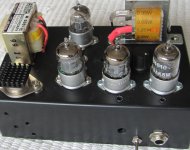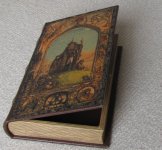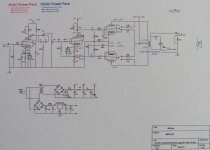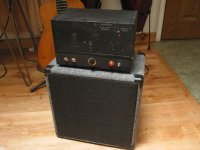By the way, can I safely assume that using these transformers, designed for a 5K load into 4 ohms, means that I could also use them for a 10K load into 8 ohms?
In other words, is the winding ratio the only factor to consider, or are there real-world engineering subtleties to consider?
In other words, is the winding ratio the only factor to consider, or are there real-world engineering subtleties to consider?
By the way, can I safely assume that using these transformers, designed for a 5K load into 4 ohms, means that I could also use them for a 10K load into 8 ohms?
In other words, is the winding ratio the only factor to consider, or are there real-world engineering subtleties to consider?
No problem at all, except you may loose low end saturation, and add high end roll-off. A bit different guitar sound, as the result.
Prototype
Very cool, and tiny too.. How does it sound?
I could use some coaching on my power supply.

The amp circuit is basically a 5C1 or GA-5, using a 6SJ7 to drive a 6EY6.
I modeled the circuit with the 6EY6 running at 350v on the plate @ 30mA, 330v on the screen @ 2mA (or slightly less), and the 6SJ7 running at 250-260v and 7mA.
Everything looks good: ripple on the 6EY6 plate is only 5mV, about 1mV on the screen, and perhaps a tenth of that on the input stage.
Then I read this article, in which a very thorough and well-documented scientific experiment on a Bassman power supply showed that over-filtering drastically changed the sound of the amp:
AC Ripple in a Class AB Power Amp [Edited to clarify: I realize they're talking about a push-pull amp running in AB, but the key point is that screen ripple on the output tube played a major role in the voice of the amplifier.]
Do I have too much filtering in my power supply (because I'm still thinking too much in 'hi-fi' mode?) Or should I just build it and see how it sounds?

The amp circuit is basically a 5C1 or GA-5, using a 6SJ7 to drive a 6EY6.
I modeled the circuit with the 6EY6 running at 350v on the plate @ 30mA, 330v on the screen @ 2mA (or slightly less), and the 6SJ7 running at 250-260v and 7mA.
Everything looks good: ripple on the 6EY6 plate is only 5mV, about 1mV on the screen, and perhaps a tenth of that on the input stage.
Then I read this article, in which a very thorough and well-documented scientific experiment on a Bassman power supply showed that over-filtering drastically changed the sound of the amp:
AC Ripple in a Class AB Power Amp [Edited to clarify: I realize they're talking about a push-pull amp running in AB, but the key point is that screen ripple on the output tube played a major role in the voice of the amplifier.]
Do I have too much filtering in my power supply (because I'm still thinking too much in 'hi-fi' mode?) Or should I just build it and see how it sounds?
Last edited:
6AK5 push pull triode pentode cathodyne self split
Schematic attached
Self split mode is the lead sound I've been looking for.
Triode mode gives apartment level volume (97dB 12" driver).
.33u cathode bypass on 1st stage give chime to clean rhythm.
I want one.
Ps. Not happy with mid scoop after 1st stage. Needs tweaking.
Schematic attached
Self split mode is the lead sound I've been looking for.
Triode mode gives apartment level volume (97dB 12" driver).
.33u cathode bypass on 1st stage give chime to clean rhythm.
I want one.
Ps. Not happy with mid scoop after 1st stage. Needs tweaking.
Attachments
Do I have too much filtering in my power supply (because I'm still thinking too much in 'hi-fi' mode?) Or should I just build it and see how it sounds?
You can simulate a HiFi amp with somewhat predictable results. A guitar amp just isn't simulatable. You will never know what is going to happen until you plug it in and crank it up. The very first electronic device I made was a guitar amp made from a Magnavox mono HiFi. I was making them from scratch using old TV parts by age 12. Some worked, some didn't. 46 years later it's still the same. Some work, some don't. Some stuff that I would throw out, others like, some stuff universally sucks, and some just rock. You don't know until you try it.
As to filtering in the power supply, it all depends on what the application is. Some players don't like the intermodulation distortion created by hum in the power supply, and sometimes it sounds cool. Generally it sounds cool where the player is playing single note at a time lead guitar. Getting a distorted chord (3 or more simultaneous notes) to sound good is a lot more difficult, add in some 120 Hz and things get cloudy quick.
The situation is somewhat different with a SE amp VS a P-P amp. In an SE amp there is little hum rejection in the output stage. A noisy power supply can be heard in the speaker with no input present and nobody likes that. Sometimes a compromise is needed to "get the hot rod to idle".
In a P-P amp, especially one biased rather hot, there is a threshold where for lower volume levels the output tubes are run class A and both tubes are conducting. Most power supply hum cancels out and the amp idles cleanly. Get everything set up right and the amp will "growl" on signal peaks. Careful listening and observation withan FFT analyzer will reveal strong 120 Hz IMD.
I was listening to a youtube clip where this effect was very pronounced and sounded good. I can't find it now. I found one where it is mildly audible and it is on an SE amp. The sound I am looking for might have been on one of this guys other amps, or it could have been far down the road of followed links.
Listen carefully to the loud parts of the notes at the 4:16 mark and at 6:14 and 6:44 for a fast tremelo type of sound.
http://www.youtube.com/watch?v=sETbe24Bu-4&feature=youtu.be
I could use some coaching on my power supply.

The amp circuit is basically a 5C1 or GA-5, using a 6SJ7 to drive a 6EY6.
I modeled the circuit with the 6EY6 running at 350v on the plate @ 30mA, 330v on the screen @ 2mA (or slightly less), and the 6SJ7 running at 250-260v and 7mA.
Everything looks good: ripple on the 6EY6 plate is only 5mV, about 1mV on the screen, and perhaps a tenth of that on the input stage.
Then I read this article, in which a very thorough and well-documented scientific experiment on a Bassman power supply showed that over-filtering drastically changed the sound of the amp:
AC Ripple in a Class AB Power Amp [Edited to clarify: I realize they're talking about a push-pull amp running in AB, but the key point is that screen ripple on the output tube played a major role in the voice of the amplifier.]
Do I have too much filtering in my power supply (because I'm still thinking too much in 'hi-fi' mode?) Or should I just build it and see how it sounds?
I do not see your PS as being overfiltered. And all parts of an amp contribute to the sound. As far as I am concerned voltage sag rather than ripple is more important.
Damn. Nice weekend to work on an amp and I end up getting run off the road by a car (me on my bike) and a good care of road rash.
Amp design is evolving. It was to be a simple self-split P-P amp. Then I saw some possibilities and figured out with a simple switch I could convert it into a self-split or a cathodyne PI. Another switch to go from Fender cleans to Marshall like crunch (well that is the theory). Might take things over the $100 but not much. Start building a temporary chassis, realize it is not going to be so temporary, decide that since I am going to keep it around maybe add another feature.
See more possibilities that have been mentioned in theory, work out my own arrangement, throw in a few more parts (and bucks), It is ending up not looking like the original idea but interesting enough just to do it to try it. Wish I had time to do both but that will not happen.
On the plus side, the box guitar sounds great, had about half a dozen players try it at work and heard what it can do. Still needs a couple more hours to finish it but close enough to get back to the amp.
Amp design is evolving. It was to be a simple self-split P-P amp. Then I saw some possibilities and figured out with a simple switch I could convert it into a self-split or a cathodyne PI. Another switch to go from Fender cleans to Marshall like crunch (well that is the theory). Might take things over the $100 but not much. Start building a temporary chassis, realize it is not going to be so temporary, decide that since I am going to keep it around maybe add another feature.
See more possibilities that have been mentioned in theory, work out my own arrangement, throw in a few more parts (and bucks), It is ending up not looking like the original idea but interesting enough just to do it to try it. Wish I had time to do both but that will not happen.
On the plus side, the box guitar sounds great, had about half a dozen players try it at work and heard what it can do. Still needs a couple more hours to finish it but close enough to get back to the amp.
Prototype
I hope those exposed primary taps on the output transformer are going to be shrouded.

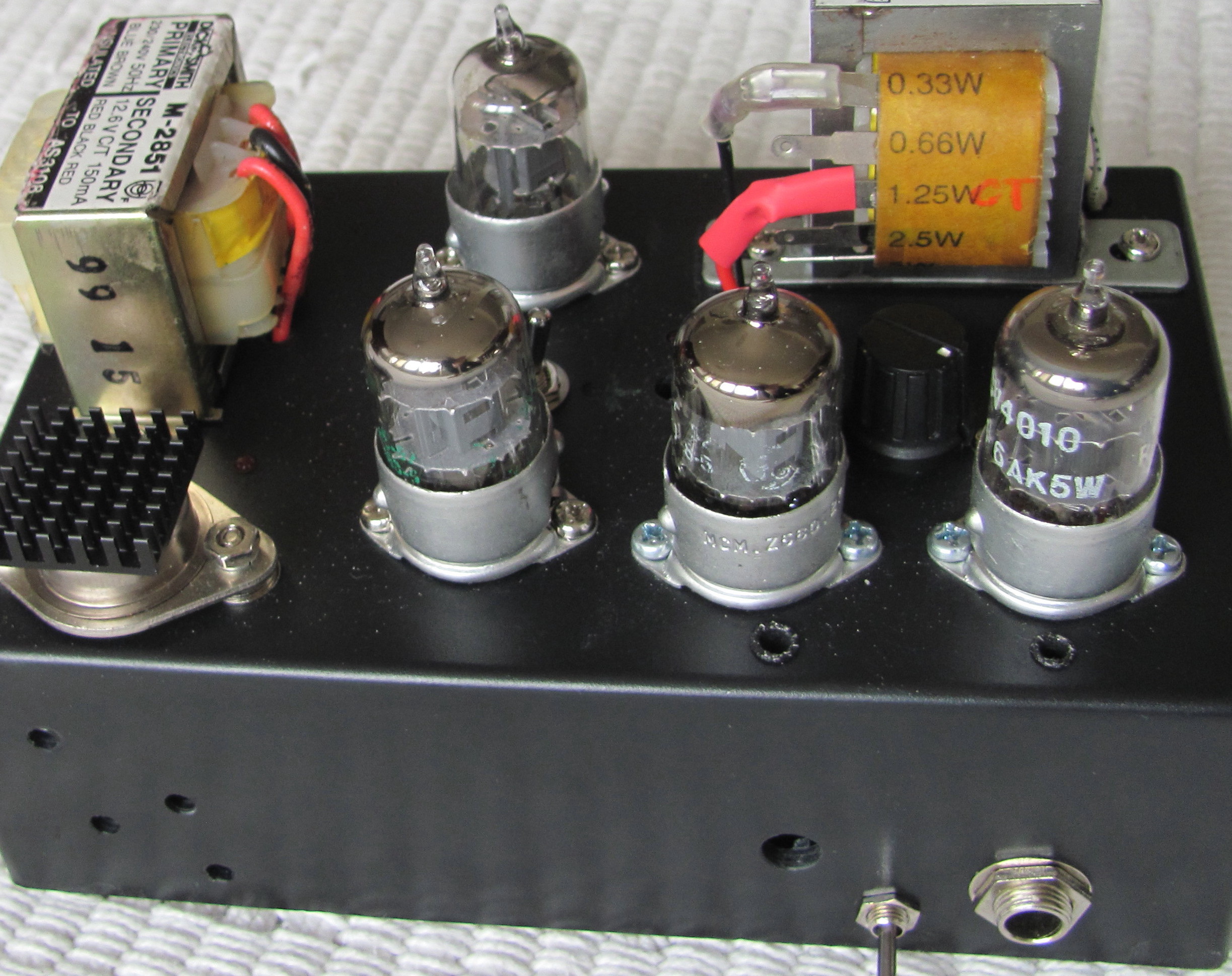
I've been playing with a couple of drivers and cabinets. I bought a Jensen C12R that I've been playing with in my test cabinet. I also have a Hot Rod Deluxe that is marked "Eminence for Fender" but for all the world looks like a Jensen C12N ;-)
...
So now I'm hot to try an Alnico speaker... Any recommendations for a 12" Alnico 25W or better for under $200?
My Weber 12A125A arrived and was promptly installed in the little cabinet, after playing with the Eminence driver for a while to recalibrate my ears.
The Weber is another level of improvement. The sound is more detailed and nuanced i.e. there seems to be more going on that changes with playing and settings. It seems to bring out the best in the sound of the electronics. The 200 Hz peak is not noticeable anymore.
The clean sound is crisp and "woody", and the sound when the electronics are overdriven is aggressive and punchy.
The 3 drivers all sound so different; makes me want to try a few more yet. But this one is good enough to let me get on with fine tuning the voicing of the electronics.
The bad news is with the Weber speaker the BOM is close to $500 now. I guess I lose the challenge but gain a nice amp
Attachments
The bad news is with the Weber speaker the BOM is close to $500 now.
I have spent about $900 on this project. My "bedroom practice amp" has morphed into a 1/2 scale full stack. OH well at least it's MY practice amp of choice. I'll sell the Guild and the Park (Marshall) amps that I have stashed and recover my investment.
As to the challenge, I should have one or more amplifiers (not counting the speaker cabinets) that contain less than $100 in parts by October.
I guess I lose the challenge but gain a nice amp
Hehe. This challenge is kind of silly when you have more than 100$ to spend and want the best possible amp for yourself. So, does it make sense to adjust yourself to a budget you don't care about? NO.
Not many students or unemployed around here. Not many either with sons who could benefit from this endeavor. So..... what's the point? I've often asked myself this question.
Before starting this I already had two guitar amps (5W SE and 15W PP). I was and still are happy with them. I didn't need another one. Specially, I didn't need a WORSE one. So, WTF am I doing in this thread? It's just a game and games must have rules otherwise there's no point playing them. And I'm still getting some fun out of this one. Speaking of rules, I'm an outlaw. I don't have a BOM and will probably never make one. So in reality I'm playing with myself and not with others. But my amp, if not eligible to win, still is within the spirit of this challenge: VERY cheap and good sounding. I DID IT. I knew I could. Who cares about the rest? I don't.
I herd a rumour, as if it was made by Jensen.
Magnavox is one of the few OEM's that often made their own speakers. Some of them were pretty good.
Look for a 3 digit EIA code number on it somewhere. Often the 3 digits are by themselves, or sometimes they are part of the date code. Jensen is 220 and Magnavox is 232.
This is the case with tubes too. RCA is 274, GE is 188, and Sylvania is 312.
Well not sure if this will be the final product, been through so many revisions already. Don't know if it would be a first time builder's amp but other than a few more parts from the amp I was planing on a couple of days ago,( ffive resistors, two switches, one MOSFET, and one capacitor).
Added a switch and resistors to reduce the supply voltage to the 12AU6 so it can run clean or dirty, might have it change the cathode resistor also but I'll see if it is necessary. Had the tone stack bypass already to go from Blackface to Tweed type tones, cut a hole out of the chassis to switch the voltage in half rather than using the voltage doubler but I probably would not have bothered with it if I did not have the hole.
Then there is the switch for the negative feedback, cathode bypass cap switch to increase the value for more of a fixed bias feel, but the real unknown is the four pole three position switch. It converts the amp PI from LTP (top and left position) to Cathodyne (center position) to paraphrase. I think I got it right, we'll see if I can get this thing to sing or if it will squeal for me.

Added a switch and resistors to reduce the supply voltage to the 12AU6 so it can run clean or dirty, might have it change the cathode resistor also but I'll see if it is necessary. Had the tone stack bypass already to go from Blackface to Tweed type tones, cut a hole out of the chassis to switch the voltage in half rather than using the voltage doubler but I probably would not have bothered with it if I did not have the hole.
Then there is the switch for the negative feedback, cathode bypass cap switch to increase the value for more of a fixed bias feel, but the real unknown is the four pole three position switch. It converts the amp PI from LTP (top and left position) to Cathodyne (center position) to paraphrase. I think I got it right, we'll see if I can get this thing to sing or if it will squeal for me.

- Home
- Live Sound
- Instruments and Amps
- The Hundred-Buck Amp Challenge
